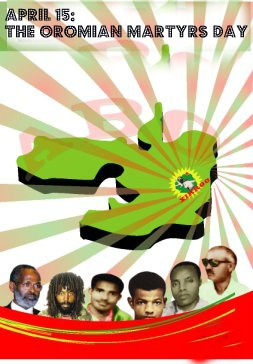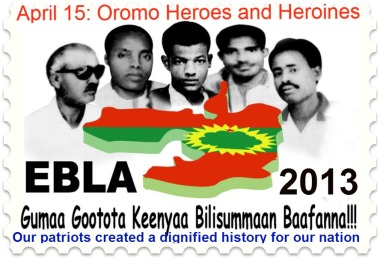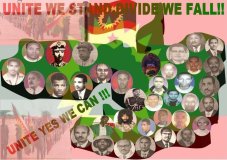BY FAYISA LEMMA | Bitootessa 30, 2014
 Akkuma beekkamu Finfinnee hardha hafteen nafxanyootaa fi wayyaaneen keesaa iyyitu kana waggaa 128 dura gosa Oromoo kan akka Gulallee, Galaan fi Oromoota biraa malee osoo qorichaafuu barbaadamee habashaan tokko keesatti hin argamu ture. Finfinnees kaansariin hin qabne ture.Qabeenya uumamaanis badhaatuu kan turtee fi lafti ishees bosinaan kan uwwifamte turte. Birbirsa/piyassa bakka yeroo ammaa siidaan nafxanyicha seexana gurraachaa Minilik irra dhaabbatu kana Odaa Yaa’a Gulalleettu irra dhaabbata ture, kun hundi jijjiiramee , qilleensa bareedaa fi qabeenya uumamaa ishee dhabdee gammoojjii tahuu ishee caalaa kan nama gaddisiisu abbaa ishee Oromoota ishee kunuunsaa irra jiraachaa turan sababa kaansarii kanaa dhabuu isheeti.Oromoon akka kaansariin kuni finfinnee hin qabannee wareegama guguddaa kafalee jira,hunda caalaa lubbuu qaqqaalii isaa itti dhabee duguuggin sanyii irra gahee jira.
Akkuma beekkamu Finfinnee hardha hafteen nafxanyootaa fi wayyaaneen keesaa iyyitu kana waggaa 128 dura gosa Oromoo kan akka Gulallee, Galaan fi Oromoota biraa malee osoo qorichaafuu barbaadamee habashaan tokko keesatti hin argamu ture. Finfinnees kaansariin hin qabne ture.Qabeenya uumamaanis badhaatuu kan turtee fi lafti ishees bosinaan kan uwwifamte turte. Birbirsa/piyassa bakka yeroo ammaa siidaan nafxanyicha seexana gurraachaa Minilik irra dhaabbatu kana Odaa Yaa’a Gulalleettu irra dhaabbata ture, kun hundi jijjiiramee , qilleensa bareedaa fi qabeenya uumamaa ishee dhabdee gammoojjii tahuu ishee caalaa kan nama gaddisiisu abbaa ishee Oromoota ishee kunuunsaa irra jiraachaa turan sababa kaansarii kanaa dhabuu isheeti.Oromoon akka kaansariin kuni finfinnee hin qabannee wareegama guguddaa kafalee jira,hunda caalaa lubbuu qaqqaalii isaa itti dhabee duguuggin sanyii irra gahee jira.
Erga Finfinneen dhukkuba kanan qabatamtee eegalee keessattuu waggaa 23 darbe babaldhachuu dhukkuba kanaatin Oromooti naannawa finfinnee jiraatan seeran ala Wayyaaneen lafa isaanii irraa buqqiffamanii bakka jiraatani fi waan ittiin jiraatan waan hin qabneef maatiin bittinaa’ee kun wardiyaa tahee,kun hojii humnaa qarshii baayyee gadi bu’aa taheen qacaramaa lafa irraa ari’ame irrattti hojjataa kan jiru yoo tahu kan humna hin qabne ammo kadhattuu karaa gubbaa tahee hafee jira. Akka fakkeenyaatti bara 2012-2013 keessa maqaa “Bole Lemi Industrial Zone” jedhun maatii Oromoo abbaa warraa 800 ol kan buqqisan yoo tahu lafa kana wayyaaneen kampaanii biyya Chaynaa,Turkii, Hindii, Koriyaa fi Xaaliyaniif addaan qooddee gurgurattee jirti. Kana qofa osoo hin taane fabrikooti bakka kana irratti ijaaraman fi kan naannawa finfinnee bakka biraatti ijaaraman hundi kunuunsa fabrikkaan tokko naannawa itti ijaarameef godhuu qabu osoo hin godhin summiin xuraawaan fabrikkaa isaanii keessaa yaa’u lagoota naannawa san jirutti dabalamuu dhaan bishaan qulqulluu faalee yeroo adda addaa horiin baayyeen dhumatee jira,lubbuu namaatirras rakkinni gahee jira . Xuriin adda addaa kan mana fincaanii dabalatee kan FINFINNEE keessa yaa’u laga akka AQAAQII faaluun uummata keenya miidhaa jira, garuu kan miidhamu Oromoo waan tahef wayyaaneen furmaata laatuu hin barbaaddu. Misooma abaaboo maqaa jedhunis akka fakkenyati Oromoota naannawa Magaalaa Mannaagashaa fi Sabbataa lafa isaanii irraa buqqifaman baayyinnaan warra isaan buqqise kanaaf hojii humna kan hojjatan yoo tahu, bakka hojiitti akkamitti akka of eeggatuu qaban waan leenjin hin fudhatinif kemikalota adda addaan dhukkuba gogaa fuudhanii kan du’ani jirus, kan waliin rakkatutti jirus baayyee dha.Kun hundi kan isaan irra gaheef Oromiyaan, lafti abbaa isaanii, kan akaakilee fi abaabileen isaanii, kan isaan hardha irra jiraachaa jiran badhaatuu fi barbaadamtuu waan taatef malee balleessaa tokkollee qabatanif miti.
Gidduu kana osoo rakinni olitti tarraahe hundi uummata Oromoo irra gahaa jiru furmaata kanaa kennuu dhiisanii kansaricha babaldhisuf,lafa daangaa finfinnee keessaa hunda gurguranii waan fixanif,lafa Oromiya tan gurguramtee hin dhumannetti darbuuf shira wayyaaneen lafa jala xaxxe maqaa magaalota naannawa Finfinne jiran Finfinnee waliin “ master plan” tokko jala galchuu jedhuun baastee dhageenye jirra, ‘ Osuma beeknuu huuba waliin nyaanne jette sareen’, kan hanga hardhaatis wallaallee osoo hin tahin falmannee falmisiisaa oromoon baayyeen itti hidhamee,tumamee, hujii fi barnoota irraa itti ari’amee,biyyaa itti baqatee malee kaansarichi Finfinnee qabate salphaan hin babaldhanne.Hardha murteen kun Oromoof du’aa fi jiruu tahuu qaba,dhukkubi kaansarii kan Finfinnee qabe kun yoo babaldhate Oromiyaa ajjeesuu akka dandahu hundi keenya beekuu qabna.Oromoon kaabaa kibbatti, bahaa dhihatti tokkummaadhaan shira wayyaanee kana dura dhaabachuu qabna,’madaa quba miilaa irra jiruf mudaamuddin nama dhukubdi’, Finfinnee irraa fagaachuu keenyaa yookin rakinni Oromoota naannawa Finfinnee irra gahaa ture fi jiru waan nurra hin gahinif yoo caldhisne seenaan nu gaafata, keesattuu dhalooti qubee “QUBEE GENERATION” shira wayyaanee kana hatattaman uummata baldhaa Oromiyaa biraan gahuu fi fincila finiinsuu irratti akkuma asiin dura godhaa turre gahee guddattu nurraa eeggama. Hanga gaafa Oromiyaan bilisoomtutti kaansarin Finfinnee qabate akka hin babaldhanne godhuu qabna,garuu kaansarichi kan fayyu yoo Oromiyaan bilisoomte qofa.

 March 30, 2014, Aden, Yemen (Aden Tomorrow) — Local residents said a number of coastal areas of Shabwa province, said hundreds of Ethiopian refugees arrived during the past three days to the coast of the province in the absence of a complete local authorities.
March 30, 2014, Aden, Yemen (Aden Tomorrow) — Local residents said a number of coastal areas of Shabwa province, said hundreds of Ethiopian refugees arrived during the past three days to the coast of the province in the absence of a complete local authorities.



 March 27, 2014 (Advocacy for Oromia) - April 15th is the Oromo Martyrs’ Day, also known as Guyyaa Gootota Oromoo. This commemorative day was first started by the Oromo Liberation Front (OLF) after the executions of its prominent leaders on a diplomatic mission en routed to Somalia on April 15, 1980. Since then, this day has been observed as the Oromo Martyrs’ Day by Oromo nationals around the world to honor those who have sacrificed their lives to free Oromia, and to renew a commitment to the cause for which they had died.
March 27, 2014 (Advocacy for Oromia) - April 15th is the Oromo Martyrs’ Day, also known as Guyyaa Gootota Oromoo. This commemorative day was first started by the Oromo Liberation Front (OLF) after the executions of its prominent leaders on a diplomatic mission en routed to Somalia on April 15, 1980. Since then, this day has been observed as the Oromo Martyrs’ Day by Oromo nationals around the world to honor those who have sacrificed their lives to free Oromia, and to renew a commitment to the cause for which they had died. First, this day allows us to remember those Oromo heroines and heroes who sacrificed their lives to restore Oromo culture, identity, and human dignity that were wounded by Ethiopian colonialism. In other words, this commemoration assists us to recognize the dialectical connection between martyrdom, bravery, patriotism and Oromummaa.
First, this day allows us to remember those Oromo heroines and heroes who sacrificed their lives to restore Oromo culture, identity, and human dignity that were wounded by Ethiopian colonialism. In other words, this commemoration assists us to recognize the dialectical connection between martyrdom, bravery, patriotism and Oromummaa. Our martyrs lost their lives while dreaming and fighting for freedom, justice, democracy, and development of their people and their country. They recognized that agitating, educating, organizing, and mobilizing a colonized and dehumanized nation for liberation requires courage, determination, bravery and self-sacrifice without fear of suffering and death in the hands of the enemy and their collaborators. We have moral and national responsibilities to achieve the objectives for which our heroines and heroes sacrificed their lives.
Our martyrs lost their lives while dreaming and fighting for freedom, justice, democracy, and development of their people and their country. They recognized that agitating, educating, organizing, and mobilizing a colonized and dehumanized nation for liberation requires courage, determination, bravery and self-sacrifice without fear of suffering and death in the hands of the enemy and their collaborators. We have moral and national responsibilities to achieve the objectives for which our heroines and heroes sacrificed their lives.
 HRLHA Urgent Action
HRLHA Urgent Action